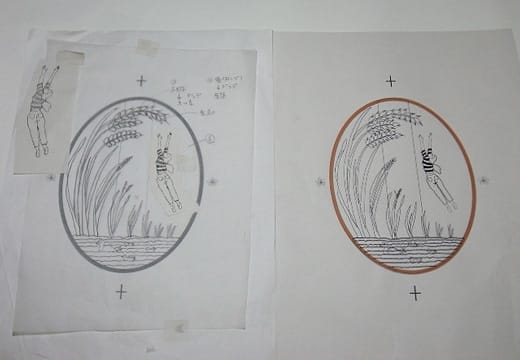シルクスクリーン版画の制作方法はこちらの
「シルクスクリーン版画の出来るまで」シリーズで
かなり詳しくお伝えしましたが
今回から補足として量産刷りの方法や
グラデーションのやり方などのお話をいたします。
私の場合 作品の多くは限定部数70~20部位ですが
最初からすべての部数を刷り上げる訳ではありません。
一作品10~20枚ほど刷って在庫とし
なくなるとまた刷り足すようにしています。
しかし たまにすべての限定枚数を最初から刷らなければならない時もあります。
つい最近その様なケースが出てきましたので 現在進行的にお話します。
I posted” the Process of Silkscreen” before.
This is its supplementary explanation.
I’d like to talk about a way of producing a large number of prints and how to make a gradation.
In my case, most of the works have about 20to70 editions each.
But I don’t print them all from the beginning.
Usually, I print 10to20 sheets per work and keep them.
When they are out of stock, I print them again.
However, I have to reprint all of the editions from scratch once in a while.
I have happened to face such a situation quite recently.
So, I talk about it according to what’s going on.

左側が鉛筆書きの原画
右側はパソコンにスキャナーで取り込んで
パスラインを作画し プリントアウトしたもの
The left, original design in a pencil
The right, the image lined on the PC and printed out

各色を分色したデータをカッティングマシンに送ってカットしたポジ
Pieces of film cut through the cutting machine according to the each color data.

上記のポジを使って 写真製版した版を刷り台にセットした状態
The printing frame using the film above.
この作品は息子の結婚式の引き出物用に制作するものです。
限定60部 量産本刷りの前に色具合などを検討するため まずサンプル刷りをします。
I’m now working on this for the party favor of my son’s wedding.
I have to print some samples beforehand, to check the tone of colors.
つづく
<おかきご飯 その後>Rice cracker in Rice- part3

例のお釜で焚いた「柿の種ご飯」!
(ピーナッツは外しました)
しかし 大きな期待とは裏腹にあまり美味しくは出来ませんでした....
不可解な事に 重要な味付けになるはずの「辛み」はまったく無くなり
おかき本体はご覧の様にメッタリと伸びきって 噛み心地も悪く
ご飯とおつまみが美味しく同時に食べられる!
という思惑は完全に外れてしまいました....
つづく....
This time I used well- known” Kaki no tane..Seeds of persimmon”
You know that” Hot one”….but strangely, its pungency was gone.
The taste was so so…
「シルクスクリーン版画の出来るまで」シリーズで
かなり詳しくお伝えしましたが
今回から補足として量産刷りの方法や
グラデーションのやり方などのお話をいたします。
私の場合 作品の多くは限定部数70~20部位ですが
最初からすべての部数を刷り上げる訳ではありません。
一作品10~20枚ほど刷って在庫とし
なくなるとまた刷り足すようにしています。
しかし たまにすべての限定枚数を最初から刷らなければならない時もあります。
つい最近その様なケースが出てきましたので 現在進行的にお話します。
I posted” the Process of Silkscreen” before.
This is its supplementary explanation.
I’d like to talk about a way of producing a large number of prints and how to make a gradation.
In my case, most of the works have about 20to70 editions each.
But I don’t print them all from the beginning.
Usually, I print 10to20 sheets per work and keep them.
When they are out of stock, I print them again.
However, I have to reprint all of the editions from scratch once in a while.
I have happened to face such a situation quite recently.
So, I talk about it according to what’s going on.

左側が鉛筆書きの原画
右側はパソコンにスキャナーで取り込んで
パスラインを作画し プリントアウトしたもの
The left, original design in a pencil
The right, the image lined on the PC and printed out

各色を分色したデータをカッティングマシンに送ってカットしたポジ
Pieces of film cut through the cutting machine according to the each color data.

上記のポジを使って 写真製版した版を刷り台にセットした状態
The printing frame using the film above.
この作品は息子の結婚式の引き出物用に制作するものです。
限定60部 量産本刷りの前に色具合などを検討するため まずサンプル刷りをします。
I’m now working on this for the party favor of my son’s wedding.
I have to print some samples beforehand, to check the tone of colors.
つづく
<おかきご飯 その後>Rice cracker in Rice- part3

例のお釜で焚いた「柿の種ご飯」!
(ピーナッツは外しました)
しかし 大きな期待とは裏腹にあまり美味しくは出来ませんでした....
不可解な事に 重要な味付けになるはずの「辛み」はまったく無くなり
おかき本体はご覧の様にメッタリと伸びきって 噛み心地も悪く
ご飯とおつまみが美味しく同時に食べられる!
という思惑は完全に外れてしまいました....
つづく....
This time I used well- known” Kaki no tane..Seeds of persimmon”
You know that” Hot one”….but strangely, its pungency was gone.
The taste was so so…





























